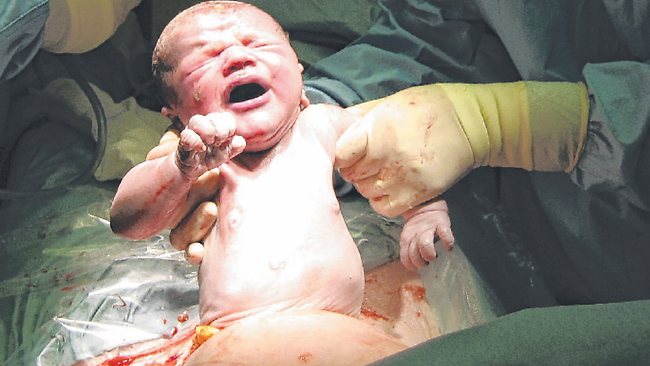Cutting down on C-sections possible
AUSTRALIA'S caesarean birth rate is double that recommended by the World Health Organization, but we have the power to change it.

AUSTRALIA'S caesarean birth rate is double that recommended by the World Health Organization, but we have the power to change it.
A shift in birthing practices could see Australia's caesarean section rate of 31.5 per cent fall for the first time in 15 years.
Australia's C-section rate is more than double the World Health Organization's suggested range of five to 15 per cent.
According to government figures, caesarean rates have risen from 20 per cent of all births in 1997 to 31.5 per cent of all births in 2009 (the most recent figures available). However, the rate rise has slowed since 2006.
C-sections are often performed when a baby is in a breech position (meaning it will enter the birth canal buttocks or feet first instead of the usual head first). But several breech birth clinics have now been established around the country, offering women the option of a vaginal birth.
New research has also found one-on-one midwife care in a Melbourne hospital reduced the C-section rate by one-fifth. Doctors say these are two indications our C-section rate can be safely reduced.
But that is not enough, says Associate Professor Stephen Robson, spokesman for the Royal Australian and New Zealand College of Obstetricians and Gynaecologists.
"The single biggest thing people can do to lower the rate of C-sections is to lose weight," Robson says. "Encouraging women economically to have children earlier in life would help too."
Unless both these things happen in addition to changes to birthing practices, Australia's C section rate will not significantly lower in the next 10 years, Robson says.
Surgery switch
There are many reasons for the increase in C-sections, Robson says. "One is an increase in obesity, which is a risk factor for caesareans. Women are also having babies later, so they're more likely to have a dysfunctional labour and develop conditions that lead to a caesarean."
Robson says the past 20 years have also seen a switch from performing difficult vaginal births to performing "safer" C-sections, "because the older, experienced obstetricians are retiring and the younger ones are taught to be more risk-averse - not surprising when they pay thousands of dollars in malpractice insurance".
In 2000, the international Term Breech Trial suggested C-sections were safer for breech babies. The study has since been criticised on several fronts, such as inclusion of some high-risk pregnancies, but many hospitals stopped performing vaginal breech births because of it. Breech births make up about
three per cent of all births.
Research has also shown that C-sections don't guarantee healthy outcomes. A study from Curtin University in Western Australia suggests women who have caesareans feel a sense of disconnection from their baby, and research from the Health Protection Association says 10 per cent of caesareans lead to infection.
 More: Birth plans for expectant mums
More: Birth plans for expectant mums
Breech birth option
"Sometimes a caesarean is suggested when a woman does not need one," says Dr Andrew Pesce, an obstetrician and director of Women's and Children's Health at Westmead Hospital in Sydney.
The hospital opened a Breech Clinic in November last year to give women with a breech baby the chance of a natural delivery. So far, the rate of vaginal breech births at the hospital has increased from five to 38 per cent, Pesce says.
"When the Term Breech Trial came out I was happily carrying out vaginal breech births," Pesce says. "[But] after reading the study I began telling patients the results - that there was a bad outcome for one in 100 breech births. Not surprisingly, they chose caesareans. But my third patient said she'd already had a safe breech delivery and would like another, as she was low risk. That made me return to assessing cases individually."
That is what happens at Westmead's clinic. Each woman is advised according to her condition and, if she is low risk, she is given the choice of having a natural birth.
"We can offer that option as we have a roster of doctors who all have experience delivering breech babies," Pesce says.
That is not the case nationwide, but Westmead hopes to rectify this by re-skilling obstetricians.
Midwives help
A recent study at Royal Women's Hospital in Melbourne found one on one midwife care throughout pregnancy and birth helped reduce the C-section rate by 22 per cent. Only five per cent of Australian women currently receive this kind of care.
"We should offer it to everyone," Pesce says. "The same goes for natural breech births. It's not financially feasible for all hospitals, but every district should nominate one centre."
Pesce believes avoiding inducing first-time mothers could also reduce the C section rate. A US-based study published in the journal Obstetrics & Gynecology found those who had their labour induced were twice as likely to need a C-section.
"People should also stop assuming that because a woman has had one caesarean, she has to have another," he says. "A vaginal birth is possible in most cases."
But with a paper in the British Journal Of Obstetrics And Gynaecology showing that as the rate of caesareans went up, death at birth in normally formed babies went down, it is clear C-sections hold an important place in modern births.
"I think society should aim for the lowest practical caesarean section rate that is compatible with safety for babies and satisfaction for women," Robson says.
Sharyn Law, 37, has had two breech babies, the second of which was delivered without a caesarean.
"My first baby was breech early on and I discussed a vaginal birth with my doctor. He'd delivered breech babies before and was happy to try if the conditions were right. But I went into premature labour and my daughter was feet first, which is riskier, so we agreed on a caesarean. I was disappointed, but wanted what was best for the baby.
"We only discovered my second baby was breech two days before she was due. But as she was bum down, full-term and a good size, the risks were low. I'd be in hospital, my doctor was skilled and happy for a natural birth, despite my previous C section, so we went ahead. All went smoothly.
"I'm proof not every breech baby can be born naturally, but it is possible in low risk cases, with the right support. I'm hoping for a conventional head first birth with my third child, but I'll do whatever is best."
For more information on pregnancy and parenting, visit kidspot.com.au



